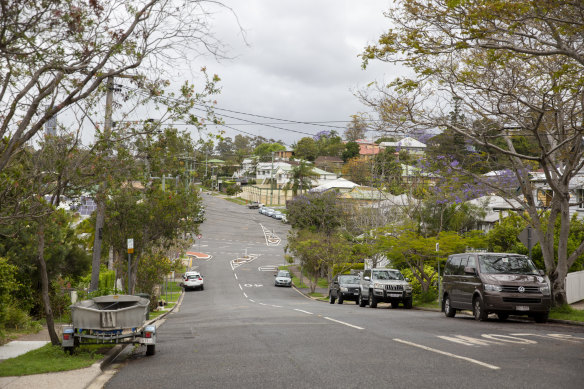- Perspective
- National
- Queensland
- City life
Do you live on Brisbane’s ‘most liveable’ street?
It’s a sign I passed nearly every day when I moved back to Brisbane: “Moray Street, ’Brisbane’s most livable street, 1993”.
Only recently, walking back from Howard Smith Wharves, did I wonder how it earned that title.
Brisbane City Council couldn’t say, but former Labor councillor David Hinchliffe, who came into office in 1988 and served for nearly 25 years, remembers the moment.

Moray Street still bears the title of Brisbane’s most liveable street from a competition held in 1993. Credit: Courtney Kruk
Three decades ago, the council was trying to reinvigorate the inner suburbs, worried that they were dying, with the rise of suburban shopping centres.
The push was on to make Brisbane the most liveable city in Australia, and as part of wider urban renewal plans, the council ran a competition to find out which street was the city’s most liveable.
“Who actually decided, I honestly can’t remember,” Hinchliffe says. But he does recall the deciding factors of liveability went beyond a street filled with “individual houses with nice picket fences”.
“Our idea of utopia was a street that was diverse, where there was a sense of community. We looked through a whole range of nominations and Moray Street stood out because it was a combination of individual houses, high-rise and medium rise, and people from all backgrounds.
“It was its diversity and the fact that it felt like a community … it became a template for what we thought was a liveable community in the inner-city.”
It seems there’s only been one similar search since 1993. Six years ago, real estate group Ray White asked 20 of Queensland’s most prominent agents to vote for the best streets in Brisbane.
Sutherland Avenue in Ascot came in at number one for its “glorious tree-lined street and classic heritage homes on large blocks of land”.
Over 50 streets were listed, with the top 10 featuring Laurel Avenue in Chelmer, Virginia Avenue in Hawthorne, Oxlade Drive in New Farm, Dickson Terrace in Hamilton, Teneriffe Drive in Teneriffe, Dornoch Terrace in Highgate Hill, Wendell Street in Norman Park, Adelaide Street East in Clayfield, and Garfield Drive in Paddington.
Moray Street came in 12th.
So, is Moray Street still “Brisbane’s most liveable street”? Do locals agree that Sutherland Avenue is Brisbane’s best? With the new year approaching, we want to find Brisbane’s current “most liveable street”, nominated by locals from across the city.
Of course, liveable means different things to different people, so we asked an urban design expert to tell us how he would measure liveability.
Greg Mews, a lecturer at the University of the Sunshine Coast, says a sense of community – the characteristic behind Moray Street’s win in 1993 – is just as important today. But the strength of a community depends on access.
“[Access] starts from when people leave their home and approach the public space, which is the street environment, in the Australian context, in most places,” Mews says.
“In Australian cities, public spaces can very quickly become conflicted spaces from an access perspective [due to] the high volume and high speed of cars in that street.”
Research shows a correlation between lower volumes and car speeds with better access and perceived safety for children and young people. The knock-on effect is how people interact with their street, neighbours and the local community.
“Of course, it’s not linear. There are other correlation effects around safety, like how well lit it is at night,” Mews says. “But [traffic is] a big compelling part of the whole package.”

Do you consider your street liveable because of how it looks and feels? Or is it all about your neighbours?Credit: Tammy Law
This theory was famously explored in the 1960s by urban design professor and Livable Streets author Donald Appleyard. He compared three similar streets with light, medium and heavy traffic, finding a correlation between lighter traffic and friendly neighbours.
This pattern of closeness or discord has continued throughout the decades in cities around the world. “It links back into a sense of belonging, how well you know your neighbours, how present the sharing community is, and how many people fill the space with life,” Mews says.
Other factors that determine a liveable street include aesthetics – tree-lined footpaths, home presentation, maintenance of green spaces, diverse housing, and character homes – and the presence of place-making artefacts.
“That can be things like trampolines in the front yard, a community library, or when children do drawings on the street itself,” Mews says.
“All these are strong indicators that there’s something going right.”
You might also consider access to a third place or social infrastructure, intergenerational housing opportunities, and proximity to services such as shops, public transport and care facilities.
It’s also likely that intangible aspects – how it feels to live there – will surface, which fits with Mews’ theory of “lovable” streets.
“Lovable delivers something more, that people are really touched to be a part of ... places that are successful over prolonged periods don’t need as much external stimulus, it’s essentially in their DNA.”
Start the day with a summary of the day’s most important and interesting stories, analysis and insights. Sign up for our Morning Edition newsletter.